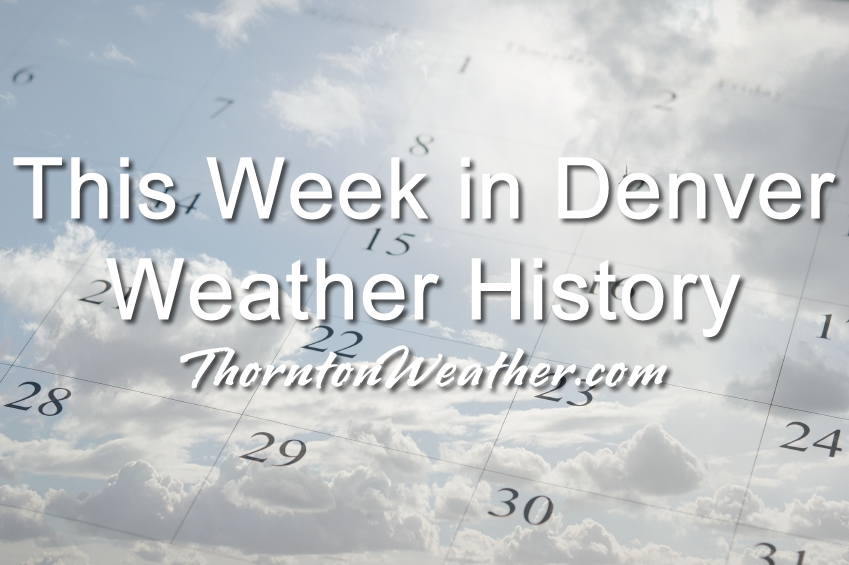
One of our coldest and driest months, January is not normally known for its weather extremes. However just like any in Colorado, significant events can occur as we see in our look back at this week in Denver weather history.
From the National Weather Service:
31-1
In 1900…low temperatures dipped to 19 degrees below zero on both days to establish daily record minimum temperatures.
In 1975…only 4.2 inches of snow fell at Stapleton International Airport…while north of Denver a major blizzard raged. All roads north of Denver into Wyoming were closed when strong winds whipped snow into 5 to 6 foot drifts. North winds gusted to 43 mph at Stapleton International Airport on the 31st…causing some blowing snow. Freezing drizzle also fell on the 31st.
In 1984…heavy snow fell in the foothills with 8 inches at Boulder and 6 inches in southern and western metro Denver. Only 1.5 inches of snow fell overnight at Stapleton International Airport.
In 1991…a New Year’s Eve snow storm dumped 2 to 8 inches of snow across northeastern Colorado. Snowfall totaled 3.4 inches at Stapleton International Airport. The 1.9 inches of snow that fell on the 31st was the only measurable snowfall of the month.
In 2008…another brief period of high winds occurred in and near the foothills of Boulder and Jefferson counties. In Nederland…the strong wind snapped a blue spruce which landed on a nearby propane tank. Some roofs in the immediate area were damaged and power lines were downed; which left 126 residences without electricity for six hours. Peak wind gusts included 90 mph at the national wind technology center…and 89 mph; 6 miles northwest of Boulder. At Denver International Airport…a peak wind gust of 23 mph was measured from the southwest.
31-6
In 1973…the 31st marked the start of a protracted cold spell that extended into January of 1974 when temperatures dipped below zero on 7 consecutive days. Record daily minimum readings occurred on the 3rd and 5th when the temperature plunged to 17 degrees below zero on both days. A record low daily maximum temperature of only 4 degrees occurred on the 5th.
31-7
In 1941…a protracted cold spell through January 7…1942… Produced below zero low temperatures on 7 of the 8 days. A low temperature of 2 degrees on the 3rd prevented a string of 8 days below zero. The coldest days during the period were the 1st with a high of 2 degrees and a low of 9 degrees below zero…the 4th with a high of 2 degrees and a low of 11 degrees below zero…and the 5th with a high of 26 degrees and a low of 12 degrees below zero.
1
In 1875…the temperature fell 27 degrees between 3:00 pm and 5:00 pm. The high for the day was 43 degrees…and the low was 8 degrees. Occasional snow flurries fell during the day…but not enough to cover the ground.
In 1885…dense smoke choked the skies over downtown Denver until midday.
In 1910…a rare trace of light rain fell during the morning.
In 1911…post-frontal northeast winds were sustained to 40 mph. Only a trace of snow fell in downtown Denver.
In 1952…snowfall of 0.03 inch was the only measurable snowfall of the month and resulted in 0.01 inch of melted snow…the only precipitation of the month.
In 1956…west-northwest winds gusted to 52 mph at Stapleton Airport.
In 1996…the first snow storm of the new year dumped more than a foot of snow in the Front Range foothills with 4 to 9 inches across the western and southern sections of metro Denver. Snow totals included: 14 inches at conifer; 11 inches at Evergreen; and 10 inches at Eldora Ski Resort… West of Boulder. Snowfall totaled only 1.2 inches at the site of the former Stapleton International Airport. North- northeast winds gusted to 30 mph at Denver International Airport.
In 2003…only a trace of snow fell at the site of the former Stapleton International Airport. This…along with a trace of snow on the 22nd…was the only snow of the month…which equaled the 1934 record for the least snowiest January.
1-2
In 1896…warm Chinook winds on the 1st became cold bora winds on the 2nd. Southwest winds sustained to 60 mph with gusts as high as 66 mph warmed the temperature to a high of 55 degrees on the 1st. Northwest winds sustained to 54 mph with gusts to 60 mph resulted in snowfall of 0.3 inch and a high temperature of only 31 degrees on the 2nd.
1-5
In 1940…the first days of the month were characterized by a mixture of drizzle…light snow…and fog. Fog occurred on each day. On the 4th and 5th considerable glazing resulted from freezing drizzle. All objects were coated with a glaze on the windward side. This resulted in very slippery streets…which caused several minor traffic accidents. The glaze was not heavy enough to damage wires and cables.
2
In 1972…strong northwest Chinook winds in advance of a cold front gusted to 51 mph at Stapleton International Airport and caused temperatures to warm to a high of 55 degrees.
In 1986…high winds occurred along the Front Range foothills. The strongest recorded gust was 82 mph in the Table Mesa area of Boulder. Other places in Boulder reported gusts from 68 to 80 mph. West winds gusted to 43 mph at Stapleton International Airport.
In 1989…high winds between 60 and 70 mph were recorded in Boulder and along the eastern foothills. No damage was reported. West winds gusted to 49 mph at Stapleton International Airport.
2-3
In 1971…a major storm dumped a total of 8.4 inches of snow at Stapleton International Airport where north winds gusted to 23 mph.
In 1972…a strong cold front late on the 2nd produced north wind gusts to 35 mph at Stapleton International Airport. Snow…heavy at times on the 3rd…totaled 6.4 inches as temperatures hovered only in the single digits.
In 2000…heavy snow fell over the higher terrain of the palmer divide to the south of metro Denver. Snowfall totaled 7 inches 5 miles southwest of Sedalia. Only 1.5 inches of snowfall were measured at the site of the former Stapleton International Airport.
2-4
In 1949…the worst blizzard in many years struck metro Denver and all of northern Colorado. The storm produced blizzard conditions with wind gusts of 40 to 50 mph all day on the 3rd when temperatures were only in the single digits. This resulted in extremely cold wind chill temperatures of 40 to 55 degrees below zero. Stapleton Airport received 13.3 inches of snow from the storm… While downtown Denver received 11.8 inches. The snow fell for 51 consecutive hours downtown. Numerous lives were lost…and livestock losses were high across the northeastern plains of Colorado where extensive airlift operations were needed to bring supplies and food to isolated communities.
2-5
In 1959…very cold temperatures…to near zero and below…caused power and gas lines…water pipes…and automatic sprinkler systems to break. In Boulder… Merchandise and furnishings were water damaged when pipes burst in a department store…flooding three floors. The temperature was below zero for 38 consecutive hours at Stapleton Airport on the 2nd…3rd…and 4th and plunged to a low of 13 degrees below zero on the 4th.
3
In 1874…heavy snowfall totaled 6 inches with 5 inches falling in 3 hours. Melted snow totaled 0.40 inches of precipitation. Northeast winds were sustained to 24 mph.
In 1887…west winds were sustained to 44 mph in the city.
In 1913…northwest Chinook winds sustained to 42 mph with gusts to 52 mph warmed the temperature to a high of 58 degrees. The low temperature was only 40 degrees.
In 1951…northwest winds gusted to 56 mph at Stapleton Airport.
In 1967…a strong Chinook wind reached 90 mph at the National Center for Atmospheric Research in Boulder. In downtown Boulder winds only gusted to 35 mph. Northwest winds gusting to 49 mph produced some blowing dust at Stapleton International Airport.
In 1986…winds gusted to 63 mph at Jefferson County Airport near Broomfield and reached 73 mph at Echo Lake in the foothills west of Denver. West winds gusted to 46 mph at Stapleton International Airport.
In 1994…high winds raked the eastern foothills. Wind gusts to 99 mph were recorded on Squaw Mountain…south of Idaho Springs…and gusts to 85 mph occurred at the Rocky Flats facility in northwest Jefferson County. Northwest winds gusted to 41 mph at Stapleton International Airport. No significant damage was reported.
In 1996…very strong Chinook winds gusting to 104 mph blasted the Front Range foothills and portions of metro Denver. Three people were injured in separate incidents. One man was injured when strong crosswinds toppled his moving van into oncoming traffic along Colorado 93 south of Boulder. Two other people received minor injuries from flying debris. At the Rocky Flats Environmental Test Facility…eleven hazardous waste storage facilities received at least 100 thousand dollars in damage. In addition…several power lines were downed leaving 3 thousand homes and stores without power. Hundreds of car windows were shattered…and several signs were toppled from buildings. Some of the strongest wind gusts included: 104 mph at Boulder Municipal Airport…98 mph in south Boulder…96 mph at Jefferson County Airport…94 mph at the National Center for Atmospheric Research southwest of Boulder…91 mph at the Rocky Flats Environmental Test Facility…and 90 mph at Wondervu southwest of Boulder. West-northwest winds gusted to only 39 mph at Denver International Airport where the Chinook winds warmed the temperature to a high of 52 degrees.
In 2004…bands of heavy snow fell across metro Denver. Snowfall totals included 6.5 inches in Broomfield and 6 inches in Westminster…Arvada…and near Hudson. Only 0.5 inch of snow fell at the site of the former Stapleton International Airport. More snow fell in the foothills with 9 inches recorded near Jamestown. Southeast winds gusted to 25 mph at Denver International Airport.
In 2006…locally high winds developed in northern Jefferson County over and near Rocky Flats. Peak wind gusts from 75 to 91 mph were recorded during the afternoon. A semi-trailer truck was blown onto its side on State Highway 93 atop Rocky Flats. Strong winds also spread across metro Denver. West winds gusted to 44 mph at Denver International Airport.
Continue reading January 1 to January 7: This Week in Denver Weather History

